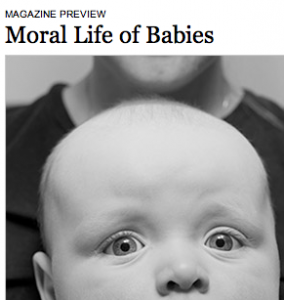 This weekend’s New York Times Magazine has a big feature that all of us who care about how kids think and learn should be reading. It’s called “The Moral Life of Babies,” and it’s about how babies become “civilized beings.” At least, I think that’s what it’s about. Honestly, it’s pretty hard to tell.
This weekend’s New York Times Magazine has a big feature that all of us who care about how kids think and learn should be reading. It’s called “The Moral Life of Babies,” and it’s about how babies become “civilized beings.” At least, I think that’s what it’s about. Honestly, it’s pretty hard to tell.
Let’s begin with the beginning:
Not long ago, a team of researchers watched a 1-year-old boy take justice into his own hands. The boy had just seen a puppet show in which one puppet played with a ball while interacting with two other puppets. The center puppet would slide the ball to the puppet on the right, who would pass it back. And the center puppet would slide the ball to the puppet on the left . . . who would run away with it. Then the two puppets on the ends were brought down from the stage and set before the toddler. Each was placed next to a pile of treats. At this point, the toddler was asked to take a treat away from one puppet. Like most children in this situation, the boy took it from the pile of the “naughty” one. But this punishment wasn’t enough — he then leaned over and smacked the puppet in the head.
I don’t know about you, but I had to read that paragraph three times to figure out which puppet was doing what. (Also: What kind of treat? I hope it was hazelnut baby formula.) And I still don’t understand exactly what the upshot is supposed to be. The kid is punishing the naughty puppet, I guess, but are we really sure? For instance, when she turned 1, my Sasha would not have understood a command to take a treat away from one puppet. Sure, she might have taken one, but she also might not have. She might’ve hit the “naughty” puppet, but she might have hit another one. Or hit you. Or me.
I guess the greater point of the article is that babies are smarter, or at least more thoughtful, than we generally think—that they can imagine what other people want or think, and can act accordingly. Which is neat, I admit, but not mega-huge-NYTM-article neat.
Maybe the problem is that the article is, um, poorly written. As my wife, who spent many hours in university biology labs, pointed out, it looks like an lab report reformatted for a major national magazine. It’s confusing and bland, and describes so many lab experiments with such cursory detail that they blend together into meaninglessness. For example:
[W]e tested 8-month-olds by first showing them a character who acted as a helper (for instance, helping a puppet trying to open a box) and then presenting a scene in which this helper was the target of a good action by one puppet and a bad action by another puppet. Then we got the babies to choose between these two puppets. That is, they had to choose between a puppet who rewarded a good guy versus a puppet who punished a good guy. Likewise, we showed them a character who acted as a hinderer (for example, keeping a puppet from opening a box) and then had them choose between a puppet who rewarded the bad guy versus one who punished the bad guy.
The results were striking. When the target of the action was itself a good guy, babies preferred the puppet who was nice to it. This alone wasn’t very surprising, given that the other studies found an overall preference among babies for those who act nicely. What was more interesting was what happened when they watched the bad guy being rewarded or punished. Here they chose the punisher. Despite their overall preference for good actors over bad, then, babies are drawn to bad actors when those actors are punishing bad behavior.
Again, I’m having a hard time following this, and it’s only after going through it several times that I’m able to sort out the action. And then I think: 8-month-olds?!? How are they “choosing” anything? A lot of infant behavioral psychology rests on “the look”—the idea that babies indicate their level of interest by how long they look at something. I’m willing to buy that, but is that the case here? Are the babies “choosing” by looking, or by actually grabbing puppets? If it’s the latter, I’m slightly less inclined to see the results as meaningful. After all, in my experience, an 8-month-old will grab whatever’s in front of her. Or maybe she won’t. There’s a randomness there that seems elided by this article.
Another thing missing from it is the sample size. Are these scientists testing a dozen, 100, 1,000 kids? If a statistically significant number of 8-month-olds consistently chose punishing puppets, that might convince me there’s something meaningful here. As it is, all we have are poorly described experiments, a lack of hard data, and ambiguous conclusions.
It pains me a little to say this, but what I want here is Malcolm Gladwell. For all his faults, he’s skilled at making goofy-sounding psych experiments like this come to life. He’d choose a single one to lead with, describe it in vivid detail, put it in context by sketching developments in infant psychology, and then he’d use it to tell us not just something about baby morality but about how our own notions of adult morality are thrown into question by what we learn about babies.
Plus, he has that kooky hair! Almost looks like a puppet, you know…

We spent a fair amount of time talking about this on our live show yesterday, and I do think the article is worth a read, regardless. I agree that the piece would probably would have been more entertaining (and less valid) if Gladwell had penned it. I’d also love for Po Bronson to Nutureshock the subject into submission, so that I would have better sense of the significance here. Because left to our own devices, the DadLabs guys take was:
a) We’re totally off the hook for teaching kids right from wrong (prewired).
b) Something about St. Augustine (ask Owen).
c) The demo of crunchy, graduate-degreed parents (hem, moms) living in University towns that take their kids in for these studies is about as broad as Glen Beck’s mind.
What they don’t tell you? What the puppets look like. Maybe the babies always picked the one with a red shirt?!?
I have to say, if morality is pre-wired then the wiring gets awfully loose as kids get older. I’ve seen some pretty immoral 2 & 3 year olds running around out there. 🙂
Maybe this explains why my kids are always all over me about things “not being fair.” I swear, they have a utilitarian moral calculus so subtle it’d make John Stuart Mill weep.
Did you watch the video? It was cute, sure. But it looked kind of like the baby “picked” the good guy by glancing at it for a split second at which point the grad student yanked the bad guy away. I don’t doubt that babies have an innate sense of justice, and I find the idea of social evolution (I might have made up that term), in which practices that allow societies to function become encoded in our DNA, very compelling. I just suspect that the research methodology was a sloppy.